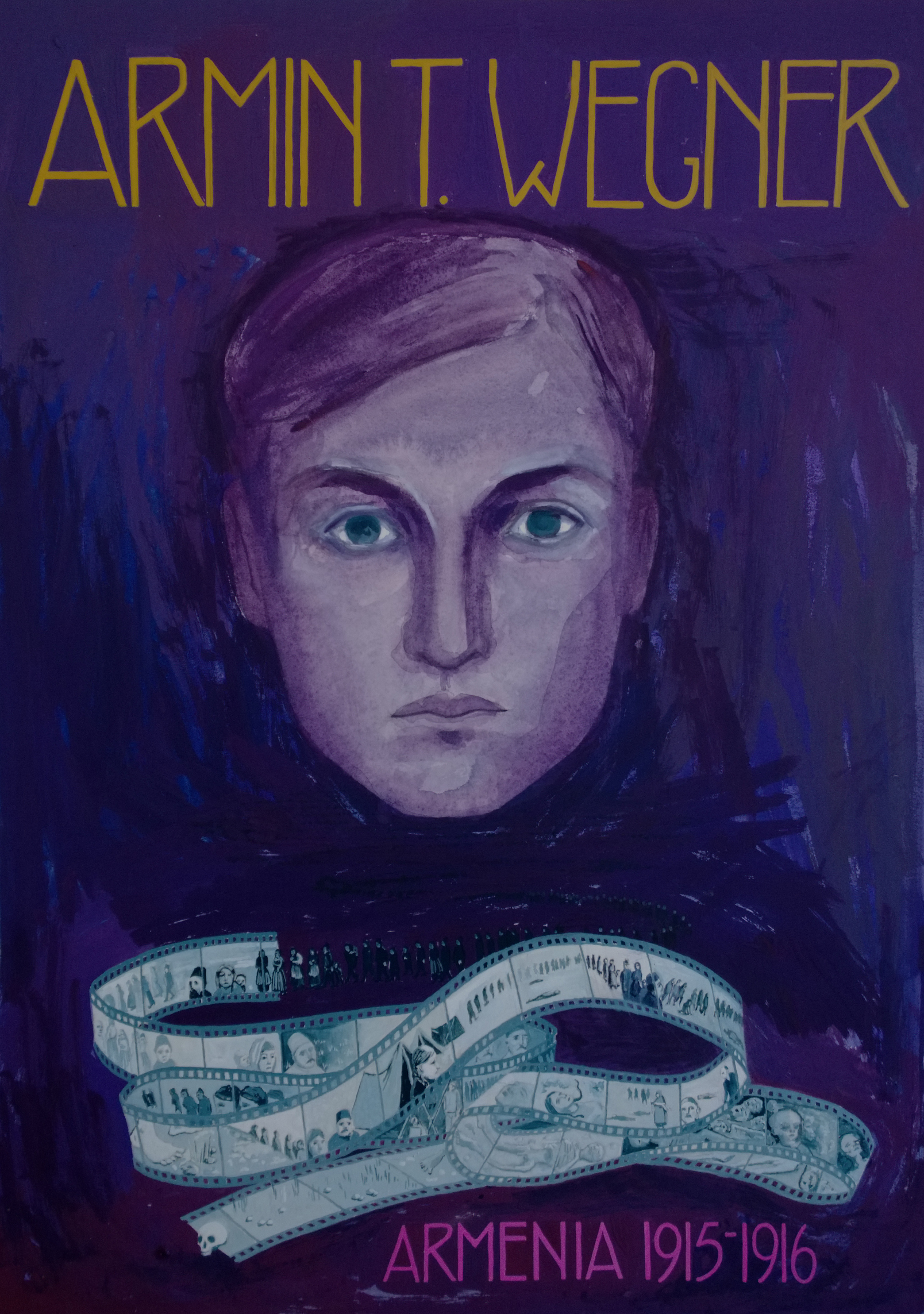Along with several other officers [2], he had risked a possible death sentence by taking the pictures in the first place. Now, returning to Germany with the ‘images of horror and accusation’ rolled into a bundle against his stomach to prevent their detection and destruction by the authorities, he was determined to do whatever he could for the victims. [3]
The year was 1916, and the name of the thirty-year-old soldier was Armin T. Wegner.
Today, these photographs – the result of German soldiers disobeying orders – form ‘the core of the witness images’ [4] of the single worst atrocity of the First World War: the Armenian genocide – the centrally planned campaign of ‘annihilation’ [5] by the Ottoman authorities that killed over a million people. [6]
‘A thousand pleading hands’
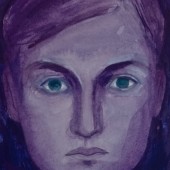 The son of an abusive Prussian civil servant and ‘the foremost radical suffragist in Breslau’ [7], Wegner had opposed the War from its outset [8], but had enlisted as a medical orderly in 1914, presumably to avoid conscription into a combat unit.
The son of an abusive Prussian civil servant and ‘the foremost radical suffragist in Breslau’ [7], Wegner had opposed the War from its outset [8], but had enlisted as a medical orderly in 1914, presumably to avoid conscription into a combat unit.
Awarded the Iron Cross ‘for assisting the wounded under fire’ [9] on the Eastern Front, in the Autumn of 1915 he was transferred to Istanbul, where the German medical mission was building a hospital, before he joined the retinue of Field Marshal von der Goltz. [10]
Over a million Armenians were deported from their homes during the genocide [11] and as he followed Goltz across Anatolia en route to Baghdad, Wegner encountered their death marches:
The roads are lined with the famished and suffering Armenian refugees, like a weeping hedge that begs and screams, and from which rise a thousand pleading hands … [12]
‘A way of no return’
In the evening Goltz’s entourage would often stop near the deportees’ makeshift camps, whose ‘very existence’ the Turks denied , while the Germans ‘acted as [if] they did not exist at all’. [13]
Unable to remain a bystander, Wegner defied orders and entered the camps [14]:
I have just returned, this very moment, from a round of inspection of the camp: hunger, death, disease and desperation on all sides. You could smell the odour of faeces and decay. From a tent came the laments of a dying woman. A mother identifying the dark violet badges of my uniform as those of the Sanitary Corps, came towards me with outstretched hands. Taking me for a doctor, she clung on to me with all her might … [15]
Perhaps even more disturbing were the dying children, ‘abandoned and reduced to animals, starved, without food or bread, deprived of the most basic human aid, packed tightly one against the other and trembling from the night cold, holding pieces of still smouldering wood to try to get warm.’ [16]
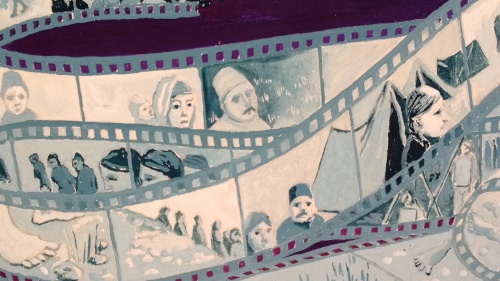 ‘All the mountain valleys, all the river banks are filled with these camps,’ he wrote. ‘Where are they going? Where? This is a way of no return.’ [17]
‘All the mountain valleys, all the river banks are filled with these camps,’ he wrote. ‘Where are they going? Where? This is a way of no return.’ [17]
He took scores of photographs in the camps – a capital crime – ‘made notes [and] wrote letters’ about the genocide, one of which was published in Germany in 1916 in his mother’s feminist magazine Die Frau der Gegenwart, and ‘carried letters from deported Armenians to Constantinople, where he gave them to [US] Ambassador Morgenthau to send back to the United States’. [18]
He would later recall having seen ‘maddened detainees eating their own faeces, women cooking the bodies of their new-born babes, [and] young girls dissecting the bodies, still warm, of their mothers, to search in their intestines [for] the gold hidden from the rapacity of the gendarmes.’ [19]
In early 1916, during a brief period of home leave, he contacted a number of dissident politicians, journalists, and opinion makers – including the editor of the Berlin newspaper Die Welt am Montag, Hellmut Gerlach – in an unsuccessful attempt to raise awareness about the genocide in Germany, and thereby change German policy towards its Turkish ally. [20]
‘Across the world … newspapers gave immense prominence to the genocide.’ [21] But in Germany the topic was verboten. [22]
Arrested
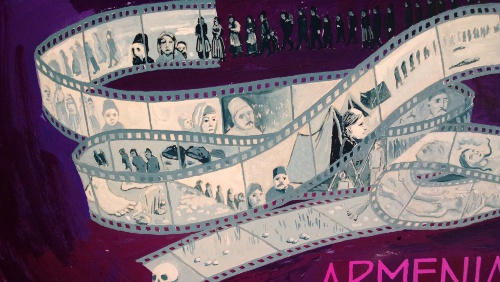 In June 1916, back on Ottoman territory, Wegner was arrested by German soldiers for censorship violations after his ‘clandestine mail routes were discovered’ and a letter to his mother about the genocide intercepted. [23]
In June 1916, back on Ottoman territory, Wegner was arrested by German soldiers for censorship violations after his ‘clandestine mail routes were discovered’ and a letter to his mother about the genocide intercepted. [23]
He was put to work in a cholera unit in Baghdad, where the senior hospital doctor was instructed that ‘[Wegner] must be utilized in such a way so as to do away with any desire … to wander around Baghdad’. [24]
Travelling back to Istanbul in October 1916, he visited still more camps, and took more photographs – the plates for which he hid ‘rolled into a bundle against [his] stomach’ to avoid detection [25] – as well as testimonies from survivors. [26]
In a ‘completely deserted camp at Rakka’ he found a thirteen-year-old boy, Manuel, who had lost his mother and brothers, and tried to intervene to save the child’s life: ‘For two hours I … offered [the Arab guards] all the cash I had on me, but they would not release the boy’, he wrote in his diary. [27]
In Istanbul he appears to have been arrested again, and was then held on board a ship until its departure for Berlin. [28]
From revolution to exile
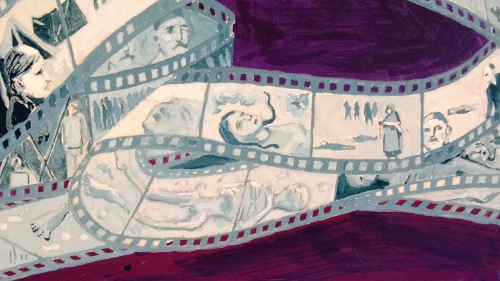 During the German Revolution of 1918/19 Wegner was a member of the Political Council of Intellectual Workers, ‘advocating the formation of a transnational peace movement based on conscientious objection’ [29], and penned an open letter to the Sparticist leader Karl Liebknecht, arguing against revolutionary violence, just days before the latter’s murder. [30]
During the German Revolution of 1918/19 Wegner was a member of the Political Council of Intellectual Workers, ‘advocating the formation of a transnational peace movement based on conscientious objection’ [29], and penned an open letter to the Sparticist leader Karl Liebknecht, arguing against revolutionary violence, just days before the latter’s murder. [30]
The following month he published another ‘open letter’, this time to US President Woodrow Wilson, drawing on his experiences of the genocide to plead the case for Armenian independence. This letter, which first appeared in his mother’s magazine, was published in the Berlin daily Berliner Tageblatt. [31]
Over the next eight years he published four books on the genocide, and lectured publicly on the topic ‘despite frequent rioting by Turkophile groups during his talks’. [32] Some of these talks featured slides of the images that he had smuggled out of Turkey. [33]
He remained active in the peace movement [34], and in 1933, bravely – if foolishly – wrote yet another open letter, this time to Adolf Hitler, protesting against the Nazis’ anti-semitism. He received a polite note from the Chancellor’s office, acknowledging receipt of his letter, before being arrested, tortured and detained. [35]
Released in the spring of 1934, with the assistance of a British Quaker attorney, he left Germany for England, and spent the overwhelming majority of his remaining 44 years in exile. [36]
‘Wilful defiance’
With his pacifist mother, progressive politics and independent spirit – Wegner had left school to work on a farm for six years, later working as a longshoreman in Marseilles before completing a doctoral dissertation on ‘The Strike in Penal Law’ [37] – Wegner might seem an atypical soldier. However, throughout the 20th century – and the 21st century to date – there have been soldiers who have resisted the wars in which they have become embroiled, often at considerable cost to themselves. [38]
In the First World War, this resistance ranged from the overt and altruistic – the most famous example of which is probably Siegfried Sassoon’s declaration ‘Finished with the war’, which he wrote as ‘an act of wilful defiance of military authority’, in protest ‘against the political errors and insincerities for which the fighting men are being sacrificed’ [39] – to the covert and rooted-in-self-preservation. [40]
After an encounter with a dead soldier following the Battle of Messines, and a religious epiphany in an Italian Church, the young British soldier Ronald Skirth made a vow that he would ‘never knowingly again help to take a human life’, and thenceforth deliberately mis-targeted his guns so as to miss human targets. [41]
In a similar vein, Harry Patch, the last surviving ‘Tommy’ to have fought in the trenches before his death in 2009, recalled how his friend Bob Haynes deliberately tried to wound rather than kill: ‘If he used that gun at all, it was about two feet off the ground and he would wound them in the legs. He wouldn’t kill them if he could help it.’ [42] Attacked by a German soldier wielding a bayonet, Patch himself – a crack shot – chose not to kill his assailant, later writing that ‘War is organized murder and nothing else’. [43]
‘I am not a bandit’
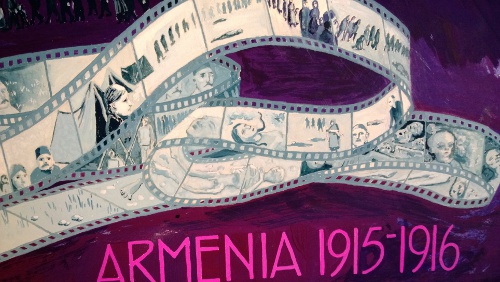 And it wasn’t just soldiers. Turkish civilians also disobeyed orders in resistance to the Armenian genocide – a point that Wegner himself was keen to make. [44]
And it wasn’t just soldiers. Turkish civilians also disobeyed orders in resistance to the Armenian genocide – a point that Wegner himself was keen to make. [44]
Thus the governor of Ankara, Mazhar Bey, pretended not to understand the written orders he had been sent regarding the deportations. And, when a government official named Atif Bey was sent to relay the orders directly, he told him:
“No, Atif Bey, I am the governor, I’m not a bandit. I cannot do it. I will get up from t[he governor’s] chair and you can come and do it.” [45]
In a similar vein Huseyin Nesimi, the senior administrator of Lice County, ‘refused to carry out the order to massacre his Armenian residents.’ He paid a heavy price for his refusal. Having ‘first demanded to receive a written order to this effect … he was removed from his position, summoned to Diyarbekir, and murdered en route.’ [46]
Other provincial and district heads who were murdered for refusing to help carry out the genocide include: ‘Basra governor Ferit, Muntefak district governor Bedi Nuri … Sabit, the acting head official of Besiri County,[and] the journalist Ismail Mestan’. [47]
The courage to disobey
Arguably ‘[w]ars happen not because as a species we have a tendency towards physical aggression, but because we have a tendency towards obedience to authority. We obey too much and resist too little.’ [48]
Indeed, ‘[e]ven at quite low levels of technology, war is a ritualised, socially-sanctioned, institutionalised group activity, based on taxation/fundraising systems, combatant training, weapons development, (food) supply management and a chain of command’- very little of which involves actual aggression or killing, but almost all of which involves strict obedience to authority. [49]
In the 2008 film The Examined Life, philosopher Cornel West notes that ‘it takes tremendous courage to think for yourself … William Butler Yeats used to say it takes more courage to examine the dark corners of your own soul than it does for a soldier to fight on the battlefield. Courage to think critically … Courage to think, courage to love, courage to hope.’ [50]
During these centenary years, there will doubtless be no shortage of voices encouraging us to remember – and celebrate – the ‘heroism’ of the men who followed orders. [51] With good reason, we choose instead to celebrate those, like Armin Wegner, Ronald Skirth and Huseyin Nesimi, who exercised true moral courage, thought for themselves and chose to disobey.
NOTES
[1] Sybil Milton, ‘Armin T. Wegner, Polemicist for Armenian and Jewish Human Rights’, Journal of Armenian Studies, 1992, Vol. IV, p. 168.
[2] Armin T. Wegner and the Armenians in Anatolia, 1915: Images and Testimonies [hereafter Images], Guerni E Associati, 1996, p.37.
[3] Milton, op.cit., p.168. It is unclear whether or not Wegner’s negatives were on glass or some form of acetate, though Milton refers to ‘approximately eighty glass positives’ in the Wegner papers at the Deutsches Literaturarchiv (Milton, op.cit., p.185, n.80). According to Dr. Zaven Khatchaturian, Chairman of the Armin T. Wegner Society of USA, Wegner ‘most likely used the latest model of German folding camera made by [the] ERNEMANN camera factory, introduced in 1911 … It took 6 cm x 9 cm negatives, which corresponds to the surviving photographs kept at the National Archive for Literature at Marbach, Germany. Interestingly, it took both rollfilm as well as glass negatives.’ (email communication, 20 October 2014). We are indebted to Dr Zaven for his help on this point.
[4] Peter Balakian, The Burning Tigris: The Armenian Genocide and America’s Response, Harper Collins, 2003, pp. 258-59.
[5] ‘In a report dated 30 June 1915, German consul general Mordtmann recounts to his superiors a conversation with Ottoman interior minister Talat Pasha … Regarding the deportation, Talat told him “what we are talking about here … is the annihilation of the Armenians”‘ (Taner Akcam, The Young Turks’ Crime Against Humanity: The Armenian Genocide and Ethnic Cleansing in the Ottoman Empire, Princeton University Press, 2013, pp. 201-202).
[6] David Stevenson, 1914 – 1918: The History of the First World War, Penguin, 2005, p. 116.
[7] Images, p.33; Richard J. Evans, The Feminist Movement in Germany, 1894-1933, p. 216.
[8] Martin Rooney, ‘A forgotten humanist: Armin T. Wegner’, Journal of Genocide Research, 2000, p. 117.
[9] Milton, op. cit., p. 167.
[10] The ‘legal cover for the genocide’ – the provisional law of 27 May 1915 which authorised the removal of inhabitants ‘individually or en masse from villages or cities and settle them in other areas’ ‘in case of military necessity, or when spying or treason are suspected’ – had been shown to Goltz by the Ottoman commander-in-chief Enver Pasha, though it is ‘unlikely [that] he understood its larger significance’. In December 1915, when he learned that ‘Armenian deportees who had made it to Mosul were about to be redeported on orders of the supreme commander in Mesopotamia’ Goltz intervened immediately, forcing the authorities to postpone the decision, and in mid-January he even threatened to resign if the deportations went ahead. In the end, however, duty trumped revulsion. ‘It was unheard of for a military man to resign in wartime,’ writes historian Isabel Hull ‘and in the end Goltz was too much a soldier to take that final step.’ (Isabel V. Hull, Absolute Destruction: Military Culture and the Practices of War in Imperial Germany, Cornell University Press, 2004, pp. 276-77, 286-87).
[11] Akcam, op. cit., pp. 258
[12] Letter dated 26 November 1915, Images, pp. 61
[13] Images, p. 51
[14] During 1915 and 1916 Wegner visited camps at Ras ul-Ain, Rakka, Meskene, Aleppo, and Deir ez-Zor: Balakian, op. cit., p. 258.
[15] Images, pp. 61-62.
[16] Images, p. 62.
[17] Images, pp. 62-63.
[18] Balakian, op. cit., pp. 259; Milton, op. cit., p. 168.
[19] Images, pp. 140-1.
[20] Milton, op. cit., pp. 168 – 169.
[21] Robert Fisk, The Great War for Civilisation: The Conquest of the Middle East, Harper Perennial 2006, p. 401.
[22] Recalling Wegner’s visit, newspaper editor Hellmut Gerlach would later write that: ‘Official censorship sealed our lips. During a press conference, we were told it was “undesirable” for us to talk about the persecution of the Armenians.’ (Images, pp. 49 – 50). Images has Gerlach referring to an ‘October 1915’ visit by Wegner, but this would appear to be a mistake. Milton, op. cit., dates this visit to early 1916.
[23] Milton, op. cit., p. 168; Images, p. 37.
[24] Images, p.37; Johanna Wernicke-Rothmayer, Armin T. Wegner: Gesellschaftserfahrung und literarisches Werk, p.33
[25] Milton, op.cit., p. 168. See also note 3. above.
[26] Images, pp. 131 – 136.
[27] Images, pp. 131 – 132. In a 28 Oct 1916 diary entry Wegner writes that: ‘Before leaving Aleppo, I went to the police station to make a request about Manuel to the officer responsible for the camps … I was forced to leave … without delivering even a word of my request’ (Images, pp. 135-136)
[28] Wernicke-Rothmayer, op. cit., p. 33.
[29] Rooney, op. cit., p. 117.
[30] Wernicke-Rothmayer,op. cit., pp. 184 – 185. Wegner was a member of the German Communist Party from February – August 1919, briefly rejoining the party after a 1927-28 visit to the Soviet Union (Milton, op. cit., pp. 169, 172).
[31] Milton, op. cit., p. 170.
[32] Rooney, op.cit., pp. 117 – 118.
[33] Milton, op.cit., p. 171.
[34] From June 1919 until early 1924, Wegner was the director of the anti-militarist group Bund der Kriegsdienstgegner (League of Draft Resisters), which he had helped to co-found (Milton, op.cit., p. 167). Around this time he also ‘travell[ed] to England, Holland and Scandinavia to promote the pacifist cause’ (Rooney, op. cit., p. 118).
[35] Images, pp. 41, 166.
[36] Milton, op.cit., pp. 173 – 174, 177, 178.
[37] Images, p. 33; Milton, op. cit., p. 167.
[38] For some examples see: ‘Memorials for German Derters’, Peace News, May 2013, http://peacenews.info/node/7238/memorials-german-deserters (WW2); Jonathan Neale, The American War (US soldiers in Vietnam); David Gee, Spectacle, Reality, Resistance (Forces Watch, 2014) and http://couragetoresist.org (21st-century wars in Iraq and Afghanistan wars).
[39] Andy McSmith, ‘A History of the First World War in 100 Moments: ‘Mad Jack’ takes on the War Office’, Independent, 11 June 2014, http://www.independent.co.uk/news/world/world-history/history-of-the-first-world-war-in-100-moments/a-history-of-the-first-world-war-in-100-moments-mad-jack-takes-on-the-war-office-9530421.html. For a copy of the original letter see http://en.wikisource.org/wiki/Finished_with_the_War:_A_Soldier%E2%80%99s_Declaration#mediaviewer/File:Sasssoon-againstwar-letter.jpg
[40] The so-called ‘Live and let live’ system – ‘where enemies stopped fighting by agreement for a period of time’ – is an example of the latter. Such truces could be forged through direct communication or indirect signalling, but they ‘were illegal at all times for they were neither created nor legitimated by authority but explicitly forbidden’ (Tony Ashworth, Trench Warfare, 1914 – 1918, The Live and Let Live System, Pan, 1980, p.19). Such truces were far from being a rare phenomenon eg. Ashworth judges that patrol ritualisation – one of the form of ‘Live and let live’, where soliders would either deliberately avoid situations where they were likely to encounter the enemy, or avoid hostilities when they did encounter them – ‘occurred in all except elite units for some of the time’ (ibid., p. 106). Some truces lasted for ‘several days, weeks or even months in rare cases where large numbers and areas were involved’ (ibid., p. 20).
[41] Ronald Skirth, The Reluctant Tommy, Pan Macmillan 2011, pp. xx, 76, 135, 182. Skirth writes: ‘I knew that what I’d done was too insignificant to warrant swelling up with pride, but it was a personal achievement, and for a humble soldier to find the opportunity to act as an individual, using his own brain and his own pair of hands independent of all authority, was as exceptional as it was satisfying.’ (ibid., p. 183).
[42] http://www.bbc.co.uk/history/worldwars/wwone/last_tommy_gallery_03.shtml
[43] Harry Patch and Richard van Emden, The Last Fighting Tommy: The Life of Harry Patch, Last Veteran of the Trenches, 1898 – 2009, Bloomsbury, 2007, pp. 96, 201.
[44] Images, p. 153. Some Turkish soldiers and civilians also intervened to save people. For example Robert Fisk recounts a story of a Turkish army corporal named Euomer who prevented Kurdish bandits from abducting a female deportee en route to Ras al-Ain, brought deportees water and protected them from further attacks (Robert Fisk, ‘All the heroes deserve remembrance’, Independent, 7 March 2001, http://www.independent.co.uk/voices/commentators/fisk/robert-fisk-all-the-heroes-deserve-remembrance-695035.html). Elsewhere, Fisk has written that ‘In almost every interview I conducted with elderly, blind Armenians who survived their people’s genocide, there were stories of individual Turks who, driven by religion or common humanity, disobeyed the quasi-fascist laws of the Young Turk rulers in Constantinople and sheltered Armenians in their homes, treating Armenian Christian orphans as members of their own Muslim families.’ (Fisk, The Great War for Civilisation: The Conquest of the Middle East, Harper Perennial 2006, p. 392).
[45] Akcam, op. cit., p. 195. The governors of Kastamonu and Yozgat (Resid Pasha and Cemal Bey) were also dismissed for refusal to follow similar orders (ibid.).
[46] Ibid., p.196.
[47] Ibid., p. 196. The senior administrator of Midyat County was also assassinated ‘upon the orders of the governor of Diyarbekir … for having resisted the order to kill the Christians in his county’ (ibid.)
[48] Milan Rai, ‘Deadly Obedience’, Peace News, March 2011, http://peacenews.info/node/3856/deadly-obedience
[49] Ibid.
[50] Astra Taylor (dir), The Examined Life (2008). The Yeats quote that West is glossing is probably: ‘Why should we honour those that die upon the field of battle; a man may show as reckless a courage in entering into the abyss of himself’ (Richard A Cardwell, The Reception of Byron in Europe, Continuum, 2004, p. 412).
[51] For example, David Cameron has spoken of the ‘extraordinary heroism’ of his great, great uncle, who – following orders – ‘helped lead the way’ into ‘a wall of German machine gun fire’ during the Battle of Kitchener’s wood (‘Scottish Conservative conference: Who was David Cameron’s great, great uncle?’, BBC Scotland, 14 March 2014, http://www.bbc.co.uk/news/uk-scotland-scotland-politics-26576906). In a similar vein, Hugo Swire has waxed lyrical about the ‘countless’ ‘tales of heroism and sacrifice’ on the part of Commonwealth soldiers during the First World War (‘First World War centenary: Britain owes a debt of gratitude to the Commonwealth’, Telegraph, 3 August 2014), while the Department for Culture, Media and Sport’s ‘Guide to Engaging Local Communities’ during the centenary lists ‘Find[ing] your local hero’ as one possible activity: https://www.gov.uk/government/publications/first-world-war-centenary-toolkit-for-local-communities

